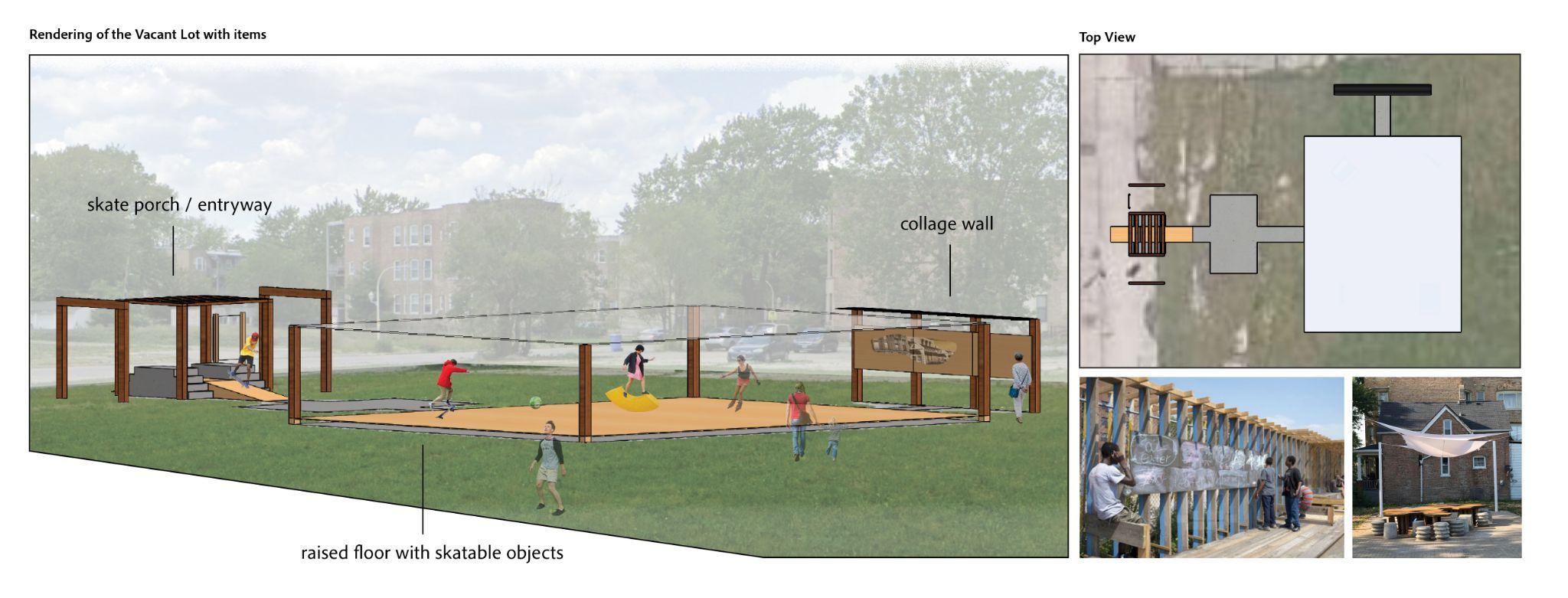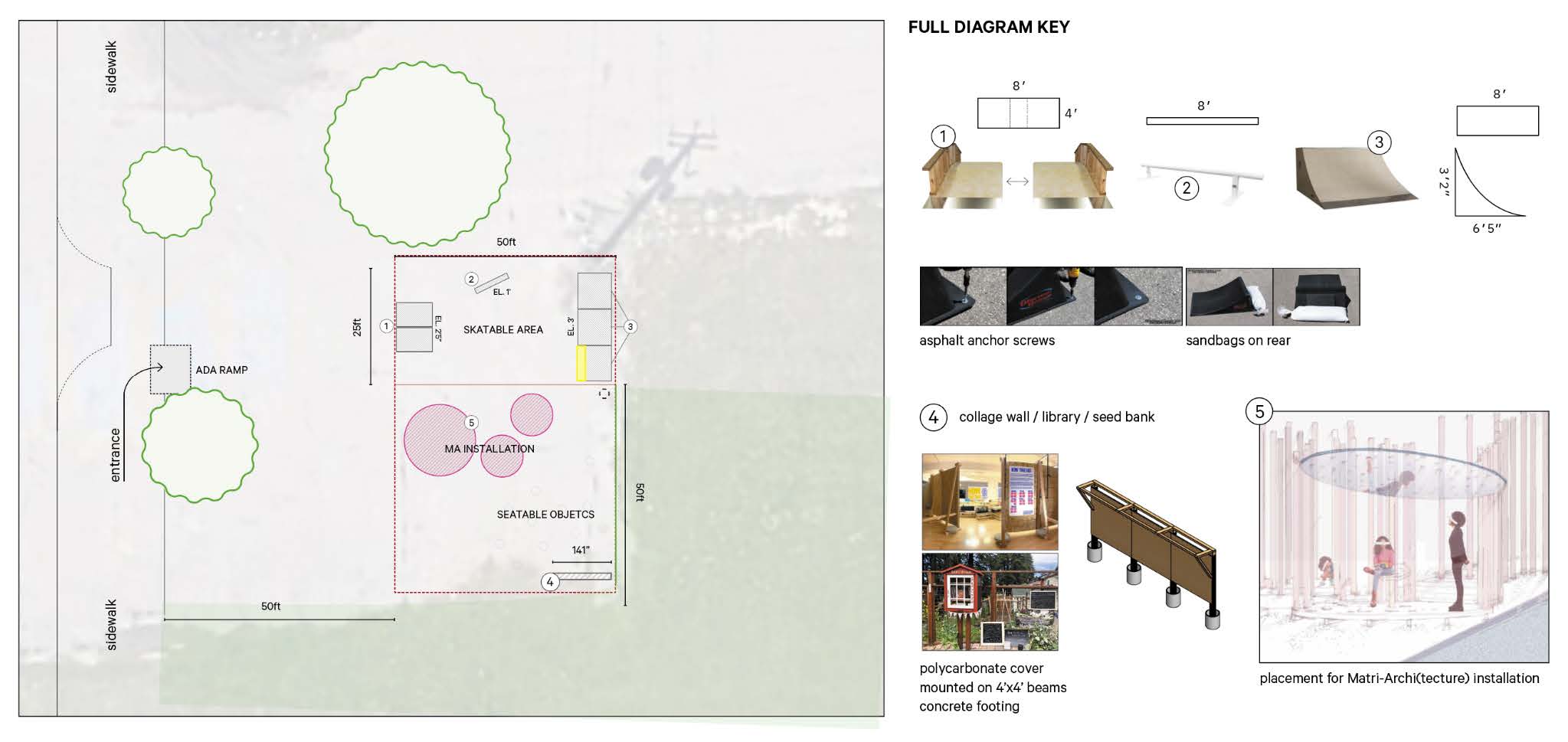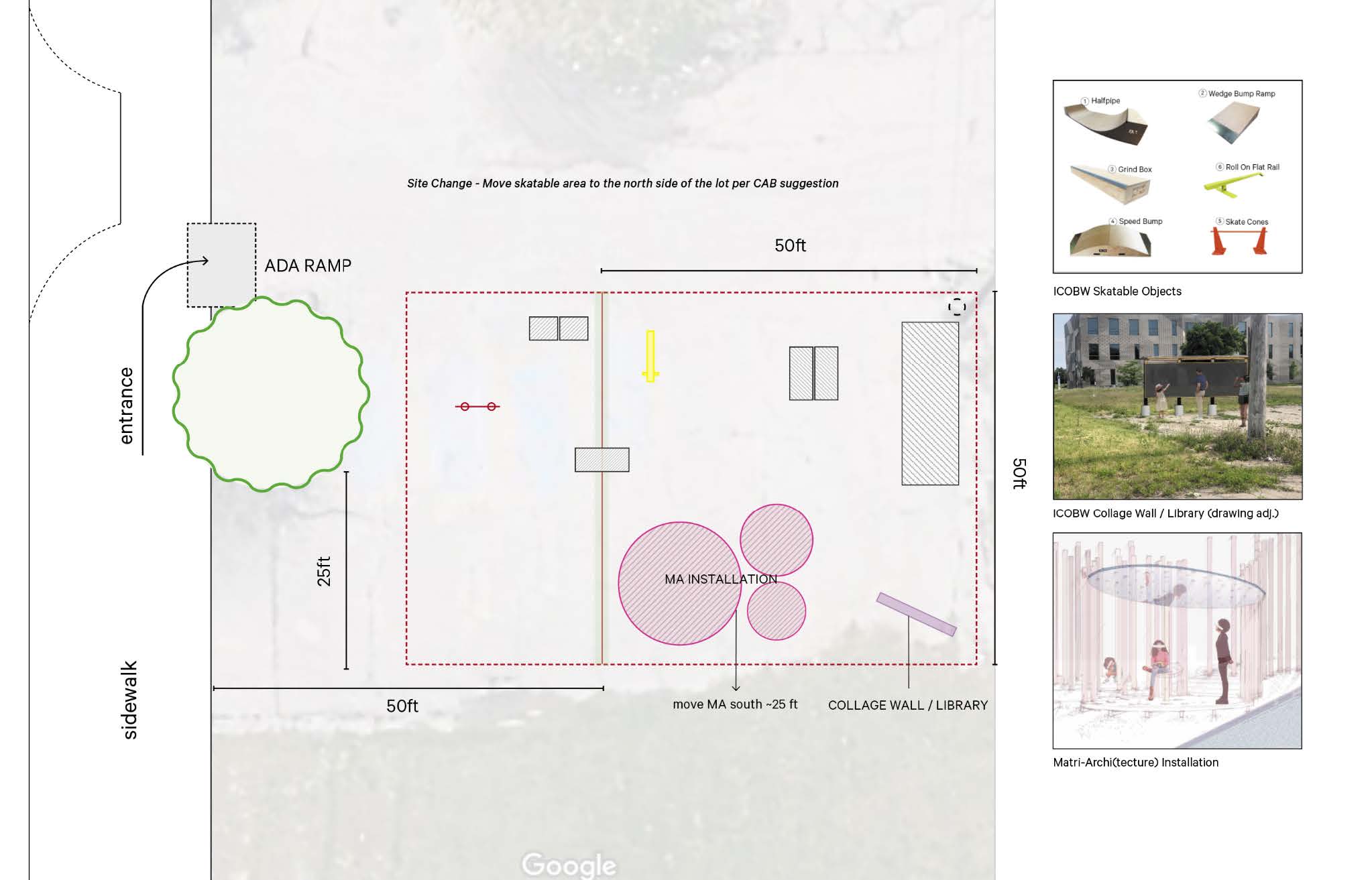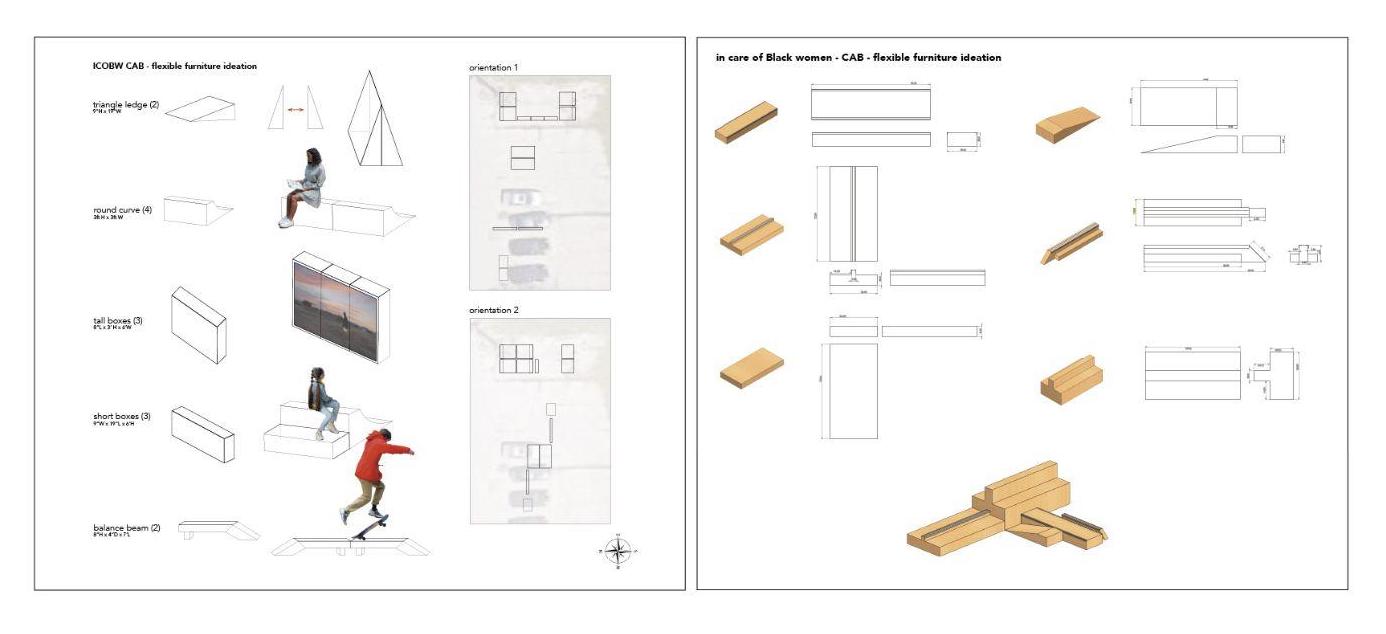Open Letter
(September 17, 2021)
The fourth edition of the Chicago Architecture Biennial (CAB), themed The Available City, opened today. Invited contributors, in ℅: Black women (in care of Black women) published an open letter, “Available to Who?”, detailing their experience with CAB, exhibition designs, and their decision to withdraw from North America’s largest international architecture show.
in ℅: Black women was founded as a creative placekeeping initiative anchored on the southside of Chicago, building functional sculptural objects and mapping cartographies of care.
Their proposal for CAB, titled “University”, was a direct response to the demolition of the University El stop on the Chicago Transit Authority’s Green Line in 1994. in ℅: Black women sought to transform an underutilized commercial space (1148 E. 63rd Street) into a physical reactivation rooted in the spirit of the historic train stop, using skateboarding as a generative means for creating public space.
Across a planning process spanning 6 months, patterns of entitlement to Black women’s labor without proper compensation (offered a basic $1,000 Organizational Honorarium), as well as
over-promising and under-delivering from municipal agencies and arts and culture institutions,including CAB, became apparent. Institutional processes and a lack of honest investment from
CAB impeded the teams’ ability to move forward. The group opted to fabricate variations of their proposed designs in-house and host a care-filled gathering with supporters of their work in lieu of exhibiting with the Biennial. The gathering featured the sittable objects created through a series of workshops by Black women, femmes, and non-binary folks this summer.
“It is an honor to be invited to contribute to high profile institutions, however, these spaces are not the sole paths to gain relevance and make critical artistic interventions. We asked ourselves: Who do we want to be available to? And why? We will continue to foster sites of care, build, and activate our book nook, sittable and skatable objects through partnerships that share our values of transparency and align with our practices of care.”
- icobw team
Read the full open
letter below:
About in ℅: Black women
in ℅: Black women was founded as a creative placekeeping initiative anchored on the southside of Chicago, building functional sculptural objects and mapping cartographies of care.
Bringing together writers, curators, farmers, mamas, dancers, organizers, teachers, cultural producers, youth, and visual artists, we explore the intersections of urban ecology, art praxis and land-use policy.
By constructing functionally designed sculptural objects, cultivating land, archiving histories, and curating exhibitions and public programs, we exemplify how communities can repair and reactivate their eco-systems while reclaiming agency over often neglected space.
Available to Who?
As Black feminist practioniters we know our stories and experiences matter. As invited contributors to the 2021 Chicago Architecture Biennial, Andrea Yarbrough, Chandra Christmas-Rouse, and Ebere Agwuncha of the in ℅: Black women (in care of Black women) team would like to address our decision to pull our exhibition from the 2021 Chicago Architecture Biennial (CAB). Across a planning process spanning 6 months, the numerous barriers of accessing supposedly “available” city-owned vacant lots became apparent. Similarly, patterns of over-promising and under-delivering as well as an entitlement to Black women’s
labor without proper compensation from municipal agencies and arts and culture institutions, including CAB became the norm.
in ℅: Black women was founded as a creative placekeeping initiative, using exhibitions and public programs to push forward the legacy of Black feminist spatial practices. Our initiative is grounded in the work of Black feminists such as The Combahee River Collective, who in 1977 wrote, “We realize that the only people who care enough about us [Black women] to work consistently for our liberation are us”. A refusal to support extractive institutional processes, particularly in arts and culture spaces, is one way we exercise an ethic of collective care. Together our team builds functional sculptural objects and maps cartographies of care. We challenge how cultural institutions often disregard the complexities of care, both for art objects and art workers. We value and prioritize art-filled spaces that are grounded in a commitment to continuing the legacy of Black feminist movements and align with our ethos of collective care.
In this spirit, Andrea partnered with Chandra and Ebere to accept Artistic Director David Brown’s February 2021 invitation to propose a project for the fourth edition of the Chicago Architecture Biennial, themed The Available City. The proposal aligned with David’s decade-long research of how collaborative, resident-led activation of vacant lots can transform a neighborhood and create permanent shared spaces. Our proposal, titled “University”, was a direct response to the demolition of the University El stop on the Chicago Transit Authority’s Green Line, located at 1200 E. 63rd Street in the Woodlawn neighborhood of Chicago. This historic station opened in 1893 and also served as the terminal stop of the Jackson Park Branch for over a decade. The station was shuttered on January 9, 1994, when the entire Green Line closed for a renovation and rehabilitation project and was never reopened for use-- creating yet another void in an already divested community.
For this specific lot - 1148 E. 63rd Street - our aim was to transform the underutilized commercial space into a physical reactivation rooted in the spirit of the historic train stop. Our team was interested in the architecture of the train stop and how to utilize skateboarding to reclaim space. Skateboarding is used metaphorically and physically not only to activate the vacant lot, but to explore the generative, creative, and productive aspects of an activity sometimes deemed “destructive” or as loitering. Is this city-owned space also a public space?
Can skateboarding create a public space, if only momentarily?
Our initial proposal featured three primary elements: 1) sittable objects, 2) a collage wall/library, and 3) a skatable porch and raised floor. (figure 1 & 2) We partnered with Natty Bwoy Bikes and Boards to activate the skatable objects through weekly lessons with youth. Similarly, the Grand Ballroom agreed to host stepping and line dancing classes. Haymarket Books donated literature to further activate our collage wall/library as a gathering space featuring our sittable objects.

Figure 1. 3 Primary Elements with 3D sketch models

Figure 2. Rendering of proposal with spatial layout on site
We were connected with Matri-Archi(tecture), an international, intersectional collective that empowers African women as a network dedicated to African-built development and spatial education, to further evolve our site. This resulted in a skate-park exhibition space with portable skateable objects, sittable objects made in workshops facilitated by in ℅: Black women, a collage wall/library to activate reading circles and a canopy designed by Matri-Archi(tecture).
During this time, we learned that there are no clear processes and procedures to access city-owned vacant lots. An AIS Right of Entry could be granted with a letter of support from the alderperson, but if secured, the City of Chicago would require the grassy area be covered with a protective barrier and 18 inches of wood chips, so as not to “disturb the soil”. The protective barrier was immediately interpreted as a financial and time challenge, prompting our site adjustment. Our designs (figure 3) were then reconfigured to use only the pavement area for the installations. We would eventually learn that the pavement area was partially owned by the city and a “community development” organization. We identified pre-fabricated skatable objects totaling approximately $5,000, that could be purchased and easily installed onsite. (figure 4)

Figure 3. Site plan featuring pre-fabricated items, collage wall, and the Matri-Archi(tecture) installation.

Figure 4. Site plan with pre-fabricated items, collage wall, and the Matri-Archi(tecture) instillation
We received a “contracted” commitment from the Biennial to fund our project on August 9th with the detailed line items: “Honorarium: $1,000 USD, Project Budget: $ TBD*USD, Program
Budget: $ TBD*USD, *Final project/program budget not to exceed $7,000-10,000 USD.” After spending countless hours in virtual meetings, updating budgets and designs, we were still
unclear with what we had access to in terms of funding from CAB and how/when those funds would be dispersed.
With five weeks until opening, we were still unclear about whether we would be granted access to activate the hybridly owned vacant lot. Hosting youth skating lessons became a challenge as the Biennial could not secure insurance to cover our “skate park” despite weeks of reassuring us that they were close to attaining coverage. This necessitated a swift pivot. Over the course of 48-hours our team designed flexible “furniture” (figure 5) that could also function as skateable objects to be fabricated locally, thereby bypassing the need for skatepark insurance.

Figure 5. Sketches and 3D models for the flexible furniture
Four weeks from opening, quotes went out to fabricators and we were presented with one estimate of $27,830, almost four times the amount of our proposed budget. Even if CAB was willing to cover overpriced fabrication, which they were not, we were opposed to the allocation of $27,830 for a temporary exhibition. Finally, updated press plans revealed that CAB intended to feature Mayor Lori Lightfoot at our site. Taken together, this solidified our experience of the Chicago Architecture Biennial as devoid of any authentic commitment to elevating the voices
and practices of the South and West side communities that they parachute into. Rather than harnessing the power of architecture and design to cultivate community-led spaces, CAB’s impact was limited in scope, their platform performative in nature.
Our vision was for an exhibition site where residents would find a sense of escapism, joy, and safety in the same lots that had previously been left unprotected. We sought to honor the history
of Woodlawn, while co-creating functional community-led spaces. We utlimately achieved this vision through hosting sittable object workshops that centered Black women, femmes, and non-binary folks as facilitators and participants. The workshops fostered a space for folks to meet new people/reconnect, learn about one another and build (image 2) in a safe environment.

Image 1,2, & 3
Finalizing the design (image 1) of the objects cultivated joy with participants. We shared reflections about the history of Woodlawn and other South side neighborhoods that are often ignored. Our goal was to preserve a sacred space and honor the work of participants, who shared that the workshops made them feel “super inspired”, “empowered”, and “blessed to be
here”. (image 3) The objects made by the participants became our sites of care and reminded us who we were accountable to. Partnering with the Chicago Architecture Biennial was not truly aligned with our practice.
Vacant lots in the city ultimately remain unavailable to local residents. And while we support David’s research initiative, The Available City, the Chicago Architecture Biennial is not creating community-led spaces or relationships that will last beyond the performance of their exhibition. We have no demands, as we do not owe anyone our experiences of being Black women, recommendations on how to be anti-racist, or listening sessions on how it feels to be engaging with institutions that do not proactively address systems of harm in its programs, exhibits and engagements. Again, we asked ourselves:
Who do we want to be available to? And why?
Amplifying and supporting art-making and spatial practices of individuals and organizations that further the legacy of Black feminists is our work. We are consciously co-creating a world that addresses divestment and the harm our communities experience daily. We know systemic changes will not happen overnight, nor through performative exhibitions. We do believe critical art interventions can be a catalyst for shifting policies and producing spaces that truly address the needs of our most vulnerable communities. We will continue to foster sites of care, build, and activate our book nook, sittable and skatable objects through partnerships that share our values of transparency and align with our practices of care. ✼
Upcoming Programming
tending to, on view: at The
Breathing Room Garden
(5045 S. Laflin)
in c/o: Black
women celebration
Sept. 16th, 6:30-9pm
in c/o: practice
Sept. 25th - Nov. 11th
(The Luminary, St. Louis, Missouri)